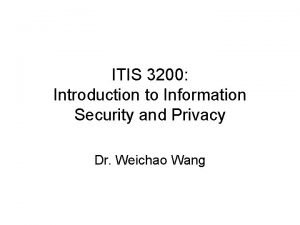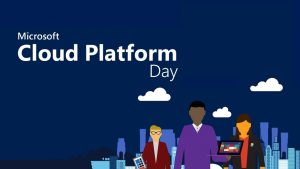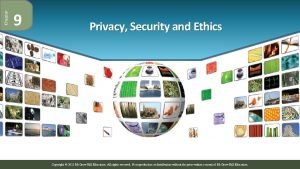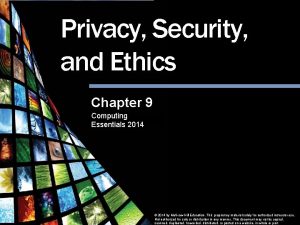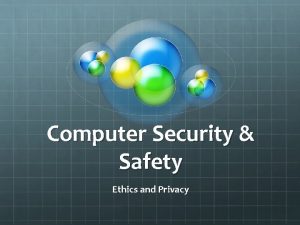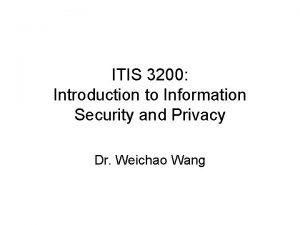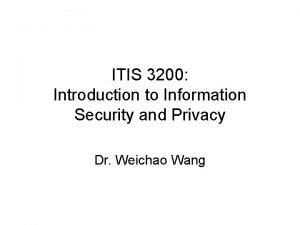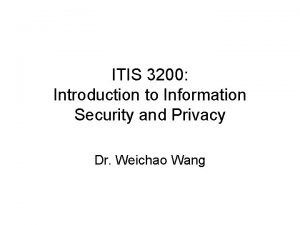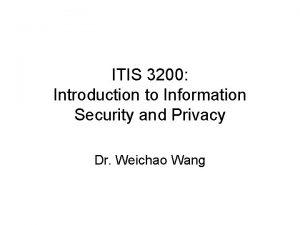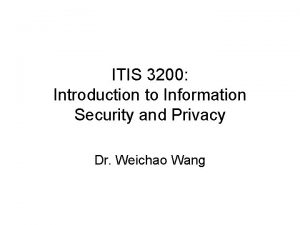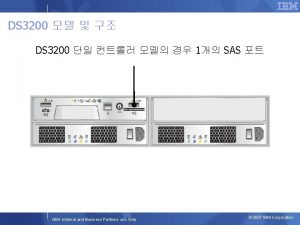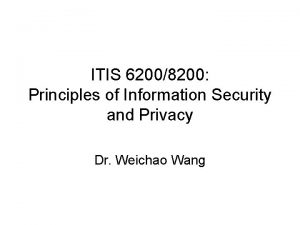ITIS 3200 Introduction to Information Security and Privacy















- Slides: 15

ITIS 3200: Introduction to Information Security and Privacy Dr. Weichao Wang

Syllabus • See handout – Homework will usually have 4 -5 questions and due in one week. It is due at the time that the class begins. – Late homework and term paper • Within 24 hours: 50% of full score • After that: 0% – Project • Individual project – Conduct some hands-on experiments – Or choose a security problem and write a survey paper – A reference question list will be provided – Midterm and final exam – Misc: eating, drinking, and cell phone (text & twitter)

Before class • An interesting question – Two companies each has some private data. They need to jointly calculate some result without disclosing their information. • Secure multiparty computation • Is this solution useful? – Zero knowledge proof: • Can I prove to you that I know a secret without telling you anything? (practically) – Anonymously publishing data or information

Perfect Storm of Social Networks • In 2011, Facebook announced they had surpassed 750 M users. Twitter claims 175 M registered users • Almost 68% of all Internet traffic is social media or search • Facebook is the 4 th largest website in the world having grown 157% between 2008 and 2009 – 1, 928% in the US alone • Social media marketing will grow from $714 M in 2009 to $3. 1 B by 2014 • Attacks on social media sites is up 240% from phishing attacks alone 4

Attacks Are On The Rise Spam, phishing and malware attacks through social media are growing: • 70% rise in firms encountering spam and malware attacks via social networks in 2009 Organizations that have been victims of attack through social networking sites ‒ Over 50% received spam via social networks ‒ Over 33% received malware via social networks 5

Examples in real life • Attack on Twitter – Hack into the victim’s email account – DDo. S to paralyze Twitter, facebook, etc • Data mining attacks on public database – In Tenn, a newspaper generates a database about all residents that have CCW permits. – In CA, there is a webpage listing all people that donate to Proposition 8 ballot measure

Examples in real life • Worm attack on smart grid • Use social network to detect disease breakout • Remotely control insulin pump of a patient • Code during the war – Navajo Code in WWII – http: //www. imdb. com/gallery/ss/0245562/W 266 R. jpg

– Computers have controlled our lives • Medical, ATM, banking, business • Air traffic control

Security overview • Risks – Why there are risks • Adversaries – Smart and dedicated – Many of them, considering the high employment rate – Hiding in the dark – From fun to profit (worm self-changing botnet target at specific systems)

Security overview • Physical security is not enough (can you be sure that your physical security methods are sound and enough? Example in Las Vegas, supply chain attacks, internal attacks) • Networked computers can be accessed remotely

Security overview • What can go wrong – Trojan war story (trojan horse): USB keys – Corrupted internal worker – Vulnerabilities of protocols or security mechanisms (security patch has problems too) – By-passing protection walls – Backdoors for systems (Linux password) – Known attacks ignored (push and poll)

Information security • Encryption – You can read the information only when you know the key • Authentication – You are who you claim you are • Authorization – The role and the right

Information security • Information integrity – The data has never be changed or changed in an inappropriate way • Non-repudiation – Cannot deny your words (digital cash example) • Privacy – Who should know, how much, how to use the information • Your cell phone or medical records • RFID • Your smart meter

Security overview • Defending methods – Prevention • • Prevent (password, salt, private salt, searching) Deter: raising the bar (password guessing, login slow) Deflect: making other target more attractive Diversify – Detection • • Monitoring (who, what, and how) Intrusion detection (signature based, anomaly based) IP telephony track Authenticity of the evidence (digital media)

Security Overview • Recovery – Recover data (check point) – Identify the damage – Forensics – Confinement • Tolerance – Maintain a decent service quality – Automatically degrade video quality while reserving bandwidth for voice
 Itis 3200
Itis 3200 Cvs privacy awareness training answers
Cvs privacy awareness training answers Microsoft from back doors gov active
Microsoft from back doors gov active Chapter 9 privacy security and ethics
Chapter 9 privacy security and ethics Chapter 9 privacy security and ethics
Chapter 9 privacy security and ethics Chapter 9 privacy security and ethics
Chapter 9 privacy security and ethics Hipaa privacy and security awareness training
Hipaa privacy and security awareness training What is the destructive event or prank the virus delivers
What is the destructive event or prank the virus delivers Private securit
Private securit Visa international security model
Visa international security model Cnss model
Cnss model Berat bayi yang baru lahir rata rata 3200 gram
Berat bayi yang baru lahir rata rata 3200 gram Gvc 3200
Gvc 3200 Ds 3200
Ds 3200 Fuji 3200
Fuji 3200 Nec 360
Nec 360
